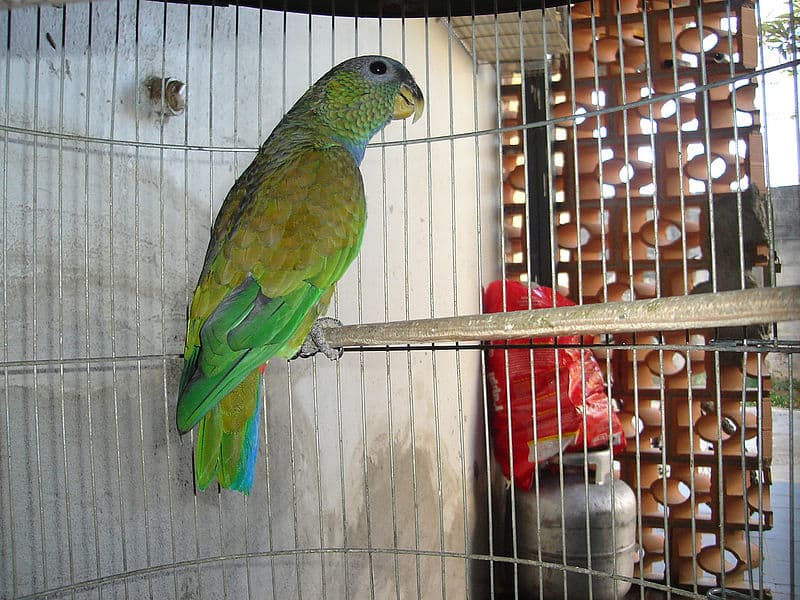The Maximilian’s Parrot appears rather plain from a distance but like the Dusky Parrot, has a variety of subtle colors that are particularly beautiful when seen in full sunlight. It is also known as the Scaly-headed Parrot because of its head feathers having grey edges giving it a scaly appearance.
The Maximilian’s Pionus, Maximilian’s Parrot, or Scaly-headed Parrot is one of the more popular and commonly kept Pionus parrots. They are becoming increasingly more popular and are favored not only for their sweet disposition, but along with the Blue Headed Pionus are noted for their talking ability and can readily be taught to speak.
These little parrots are very inquisitive, intelligent and have very good memories. Once they have learned a behavior such as stepping up they are very obedient and will remain steady in their training.
The Maximilian’s Pionus has one of the nicest pet bird personalities. It is a perfect pet for first-time parrot owners and makes a wonderful family pet since they may be handed by several people and maintain their sweet disposition. It is also a great pet for people who live in apartments or in close proximity to neighbors (where noise can be a problem) because they have a relatively quiet calm personality and are easy to maintain.
- For information about the care of Pionus Parrots see: Guide to a Happy, Healthy Pionus
Scientific Classification
| Kingdom: | Animalia |
| Phylum: | Chordata |
| Class: | Aves |
| Order: | Psittaciformes |
| Family: | Psittacidae |
| Genus: | Pionus |
| Species: | maximiliana |
Scientific Name
Pionus maximiliana
Subspecies: Pionus maximiliana maximiliana
Pionus maximiliana melanoblepharus
Pionus maximiliana siy
Pionus maximiliana lacerus
Distribution
These birds are found over much of eastern South America from north Brazil to Bolivia, Paraguay, and Argentina. They inhabit lowland forests and open woodlands.
Description
The Maximilian’s Pionus, though not the largest of the Pionus species, is a small to medium size stocky parrot with a wonderful personality. They are pale green with a more bronze color on the underparts. The back and wing feathers can range from dark to light olive-brown and many of the feathers are edged in various shades of blues and greys. The head feathers have grey edges giving them a scaly appearance, the forehead is almost black, and the cheeks are green edged in a dull blue. The chin and across the lower throat are a dusky blue or violet which will vary in intensity from bird to bird. The central tail feathers are green with the outer feathers being blue and they have the bright red undertail feathers distinguishable to all the pionus. The beak is a yellowish horn color getting darker close to the head, the eye is dark brown circled by an eye ring varying from white to gray, and they have gray legs.
Juveniles have paler coloring and less blues on their throats than the adults.
Size – Weight
These birds are a medium-sized Pionus and grow to a length of 11 /2″ – 11 3/4″ (29 – 30 cm).
Care and feeding
A roomy cage is required unless the bird is to be let out for extended periods. Many birds can spend a good deal of their time on a play pen or parrot perch.
They eat a variety of seeds, fruits, berries, and greenstuffs. Including a formulated diet would also be beneficial.
- See About Pionus: Housing and About Pionus: Care and Feeding for more information.
Social Behaviors
In the wild they are generally seen in pairs or in small flocks of up to about 50 birds. These birds tame very easily and are very sociable. They are not loud like many conures and amazons. They have very steady personalities and do not tend to bite.
- See About Pionus: Social Behaviors for information on developing a well rounded pionus.
Breeding/Reproduction
There is no visible means of sexing these birds. Place a nest box high up in a dark area of the aviary. The female will lay 3 to 5 eggs which incubate for about 26 days. Pairs may take mealworms and greenstuffs when they have chicks in the nest. Corncob is a favorite weaning food. The young will wean in about 2 1/2 – 3 months.
- See About Pionus: Breeding/Reproduction for more information on breeding.
Potential Problems
The Maximilian’s Pionus is a relatively healthy bird, though the Pionus parrots have been known to be more susceptible to the infection aspergillosis than other species. The main symptom is heavy, belabored breathing.
- See About Pionus: Potential Problems for information on health.
Availability
This bird is frequently available. They are becoming increasingly popular and are widely kept.
The other two most frequently available pionus are the Blue-headed Pionus and White-crowned Pionus.
Pionus maximiliani (Image Credit: Alex Knowles, Wikimedia Commons CC BY-SA 2.0 Generic)
